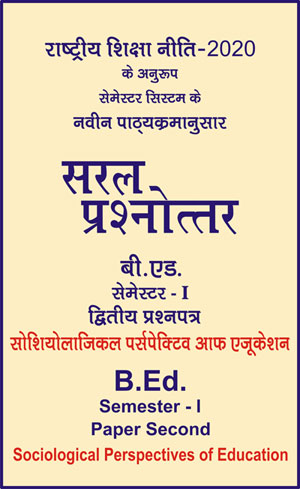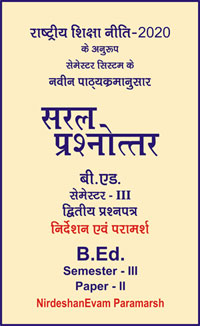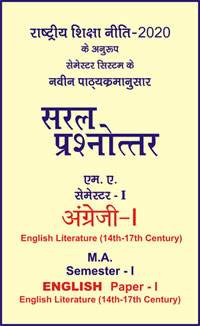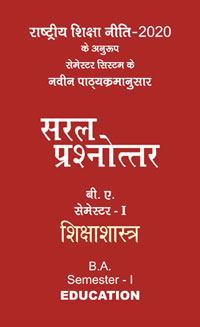|
बी एड - एम एड >> बी.एड. सेमेस्टर-1 प्रश्नपत्र-II - सोशियोलाजिकल पर्सपेक्टिव आफ एजूकेशन बी.एड. सेमेस्टर-1 प्रश्नपत्र-II - सोशियोलाजिकल पर्सपेक्टिव आफ एजूकेशनसरल प्रश्नोत्तर समूह
|
|
|||||||
बी.एड. सेमेस्टर-1 प्रश्नपत्र-II - सोशियोलाजिकल पर्सपेक्टिव आफ एजूकेशन (अंग्रेजी भाषा मे)
Chapter 3 - Equality of Educational Opportunities
Question- Explain the concept of equality of educational opportunity with reference to India. Discuss the measures and provisions made by the Government regarding equality of Educational opportunity in terms of caste, minority, disabled, gender and the disadvantaged.
Or
Enumerate the Governmental efforts to equalize educational opportunities in India at School Level.
Ans.
Regarding equalisation of educational opportunity the report of the Education Commission 1964-66 states “one of the important social objectives of education is to equalize opportunity, enabling the backward or underprivileged classes and individuals to use education, as a lever for the improvement of their condition. Every society that values social justice and is anxious to improve the lot of the common man and cultivate all available talent, must ensure progressive equality of opportunity to all sections of the population. This is the only guarantee for the building up of an egalitarian and human society in which the exploitation of the weak will be minimized”.
Inequalities of educational opportunities arise in various ways. In places where no primary, secondary or collegiate institutions exist, children do not have the same opportunity as those who have these facilities in the neighbourhood. This handicap should be overcome by the widest dispersal of educational institutions, consistent with economy and efficiency, by instituting and adequate scholarship programme, by providing the needed hostel facilities or by making suitable transport arrangements.
Another cause of inequality of educational opportunity is the poverty of a large section of the population and the relative affluence of a small minority. Even in the neighbourhood of an educational institution, children from poor families do not have the same chance as those who come from richer ones. To overcome these handicaps, it is desirable to abolish fee progressively, to provide free books, stationery and even school meals and uniforms. In addition it is necessary to develop a large programme of scholarships.
Gross inequalities give rise to differences on home environment. A child from a rural household or an urban slum having non-literate parents, does not have the same opportunity which a child from an upper class home with highly educated parents has. These inequalities are obviously the most difficult to overcome and here progress essentially depends on the general improvement in the standard of living of the population. But something can be done by ensuring that special attention at school is paid to children from the underprivileged groups and provision of day study centres or boarding houses.
Two other forms of educational inequalities, which are peculiar to the Indian situation, need attention. The first is the wide disparity between the education of boys and girls at all stages and in all sectors of education. The second is the wide disparity of educational development between the advanced classes and the backward ones-the scheduled castes and the scheduled tribes. On grounds of social justice as well as for the furtherance of democracy, it is essential to make special efforts to equalize educational opportunities between groups.
Meaning of Equality of Educational Opportunity : The concept of equality of educational opportunity has passed through various stages of evolution in history. At present equality of educational opportunity has been interpreted “as the opportunity to start together, to benefit from staggered starts, to run on the same track, and to run or progress together.” According to NPE 1986, Equality of Education means “to provide for equal opportunity to all not only in access but also in the conditions for success.” Equality of educational opportunity has been taken as “equalization of access by a suitable manipulation of educational inputs (like physical facilities and equipment in schools, quality of teachers and curriculum, and financial assistance for the poor). To others, it has meant an equalization of result of education well, that is equalization of educational achievement and benefits accruing from it.”
Equality of Educational Opportunities at the Primary Stage : Primary education is the basic education of human child. The term primary suggests that it caters to the most fundamental needs of all men and women and it is that stage of education, without which men cannot qualify themselves for a group life. Therefore, Article 45 of the Directive Principles of State Policy in the Constitution of India declares. “The state shall endeavour to provide... for free and compulsory education for all children until they complete the age of fourteen years.” Thus to provide equal opportunity to all children primary education has been made compulsory, free and universal.
Equality of Education Opportunities at the Secondary Stage: Equality of educational opportunities are important not only at the primary stage of education, but also at the secondary stage for the survival of a democratic society like India. At the secondary level equality of educational opportunity implies provision of diversified curricula to suit the differing needs and interests of individuals. Individuals are not only alike in certain respects, but they differ from each other. A good educational system can meet the needs of their differences. Students differ from each other on the basis of their unique interests, abilities and attitudes. Therefore, a diversified course is essential.
Provisions for Promoting Equality of Educational Opportunities : Provision of equality of opportunity is the demand of modern times. Universal demand arises mainly from two considerations “Firstly, there is the purely ideological reason that the right to education is a universal human right (Art: 26 (1) of the Universal Declaration of Human Rights). From this point of view, education is a fundamental right. No person should be denied this right, on grounds of caste, colour, creed, race, religion, place of birth or anyone of them.
Sociological Perspectives of Education – II Paper / 107
The second reason for this demand arises out of the desire of people for more and more education. People believe that more education can improve their socio-economic status.
Objectives of Equalization of Educational Opportunities for the SC/ST Students
(i) Educational backwardness amongst the Scheduled Castes and Scheduled Tribes has been due to social deprivation and economic poverty meted out to these communities in the pre-independence period.
(ii) The inequalities in educational development between educationally backward communities and other sections of Indian society ought to be minimised by special efforts.
(iii) The behavioural discrimination shown towards the children of the Scheduled Castes and Scheduled Tribes, even inadvertently, result in their disinterest in studies, and their early withdrawal from educational pursuits.
(iv) Teachers have a special role towards the education of children of these communities, especially to first generation learners.
(v) Teachers have a role to sensitise the parents and community members of the Scheduled Castes and Scheduled Tribes on the schemes and incentives for them and to motivate them to educate their children.
(vi) A crash programme of universal functional literacy and teacher’s whole hearted participation would bridge the gap and imbalance in the education of the Scheduled Castes, Scheduled Tribes and other communities in Indian society.
Steps to be Taken : The following are some important steps which should be taken by the schools to facilitate the SC/ST students education.
(i) The teacher’s example in his/her own behaviour towards students belonging to Scheduled Caste and Scheduled Tribe communities is the most powerful way to build up a congenial climate.
(ii) As a rule, the school staff should seek, provide and ensure nondiscrimination between the children of Scheduled Castes, Scheduled Tribes and other communities.
(iii) Use of caste names or derogatory words while calling roll calls or naming children should be devoided.
(iv) Teachers should lead all the children equally to participate in the curricular and co-curricular activities of the school, including games.
(v) Frequent meetings between the staff, school teachers, and parents of Scheduled Castes and Scheduled Tribes children should be arranged. At these meetings, details of the schemes for promoting education amongst Scheduled Castes and Scheduled Tribes should be explained. It should be impressed upon them that they must continue the education of their children. Special attention should be paid to motivating them for the education of girls.
(vi) If there is an adult education centre in or around the school, teachers should suggest to illiterate parents the advantages gained by attending functional literacy classes in the centre.
The NPE 1986, regarding education for women’s equality states. “Education will be used as an agent of basic change in the status of woman. In order to neutralise the accumulated distortions of the past, there will be a well-conceived edge in favour of women.” The National Education System will play a positive, interventionist role in the empowerment of women. It will foster the development of new values through redesigned curricula, textbooks, the training and orientation of teachers, decision-makers and administrators, and the active involvement of educational institutions. This will be an act of faith in social engineering. Women’s studies will be promoted as a part of various courses and educational institutions encouraged to take up active programmes to further women’s development.
The removal of women’s illiteracy and obstacles inhibiting their access to, and retention in, elementary education will receive overriding priority, through provision of special support services, setting of time targets, and effective monitoring. Major emphasis will be laid on women’s participation in vocational, technical and professional education at different levels. The policy of non-discrimination will be pursued vigorously to eliminate sex stereo-typing in vocational and professional courses and to promote women’s participation in non-traditional occupations, as well as in existing and emergent technologies.
First we understand the concept of different types of Impairment :
(i) Impairment : Impairment is nothing but the physical defect of an individual. It is the biological aspect of life. It develops either due to overwork or accident or due to hereditary factors. It decreases mobility, and limits the range and depth of interpersonal and social relationships, which causes psychological problems.
(ii) Disability : Disability is the behaviour evolving from the impairment. Impairment imposes limitations upon an individual’s capacities and levels of functioning. Frequent or prolonged periods of hospitalization, medical treatment and need for special drugs may develop disability. Disability in this sense is temporary. Disability has a cultural aspect also. How the culture of a particular society deals with impairment, determines disability. In most cases, the negative feelings and reactions from physically able children may develop a tendency towards disability. The visually impaired or the hearing impaired or the mentally retarded persons are permanently disabled. These impairments prevent them from entering certain occupations in life.
(iii) Handicaps : Anything is a handicap, if it prevents someone from doing what he wants or ought to do. Handicap as a technical term which refers to conditions such as blindness, deafness or very low intelligence, which most people would agree are disadvantageous. But there are bound to be disagreements about where the line is drawn between minor and real handicap and of course, there can be paradoxical cases where real handicap is turned to advantage—a beggar’s livelihood from defect of deformity, a serious wound that takes the soldier away from the risks of fighting or a child’s ailment that gains him special sympathy.
There are ten officially recognised categories of disabled children requiring special educational facilities—children who are (1) blind (2) partially sighted (3) deaf (4) partially hearing (5) educationally abnormal (6) epileptic (7) maladjusted (8) physically handicapped (9) affected by speech defect and (10) delicate.
In modern sense special education is applied to education of the disabled and gifted children, but not usually used with the majority of average children Webster defines “special” as “distinguished by some unusual quality; uncommon; not worthy; extraordinary; additional to regular, extra or employed for a certain purpose in addition to the ordinary.” This meaning of “special” is applicable to special education, which aims at modifying school practices to help the students with unique, uncommon, unusual quality. It also aims at the modification of school organization and “instructional procedures” used in general school system.
Seen from this angle, it appears that the national goals of development, integration, excellence, and equity cannot be fulfilled without ensuring that every child in the country crosses a minimum threshold of educational attainment. Even for facing the challenges of the world of to-day a minimum level of education is essential for the development of individual personality, appreciation of the constraints and potentials of environment, internalising a value system, imbibing and awareness of social responsibilities and the acquisition of specific capabilities to deal with life. In the years to come, a general spread of this level of education will become crucial to survival. Hence universalisation of elementary education has to be one of the essential ingredients of a national strategy.
Recommendations of the NPE 1986 on Equal Opportunity of Education of Disabled Children : The NPE 1986 states, the objective should be to integrate physically and mentally handicapped with the general community as equal partners, to prepare them for normal growth and to enable them to face life with courage and confidence. The following measures will be taken in this regard.
(i) Wherever it is feasible, the education of children with motor handicaps and other mild handicaps will be common with that of others.
(ii) Special schools with hostels will be provided, as far as possible at district headquarters, for the severely handicapped children.
(iii) Adequate arrangements will be made to give vocational training to the disabled.
(iv) Teacher’s training programmes will be reoriented, in particular for teachers of primary classes, to deal with handicapped children.
(v) Voluntary effort for the education of the disabled will be encouraged in every possible manner.
|
|||||

 i
i 










